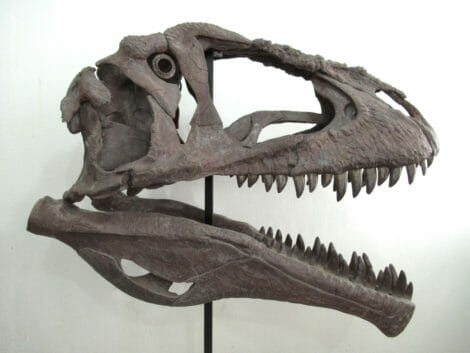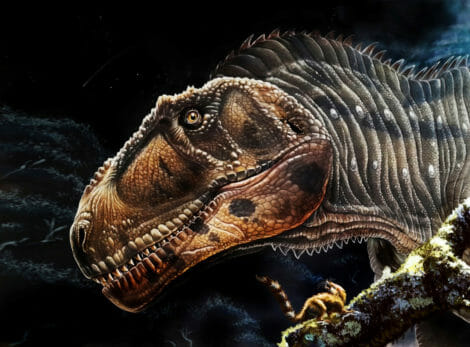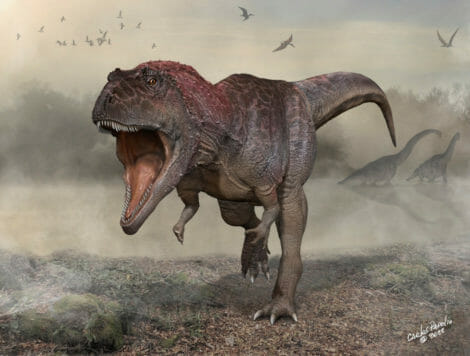Argentine ‘gargoyle’ shows how huge predatory dinosaurs evolved

A reconstruction of the skull of Cretaceous Period meat-eating dinosaur Meraxes gigas, whose fossils including a nearly complete skull were unearthed in Argentina’s northern Patagonia region, seen in an undated handout photo. Meraxes, which lived about 90 million years ago, is estimated at about 36-39 feet (11-12 meters) long and about 9,000 pounds (4 metric tons). Javier Pazo and Lautaro Rodriguez Blanco/Handout via REUTERS.
Fossils found in Argentina of a ferocious dinosaur with a huge head covered in bumps and crests reminiscent of a gargoyle are providing insight into the evolution of some of Earth’s biggest predatory dinosaurs including a curious trend toward puny arms.
Scientists said Thursday they discovered in northern Patagonia extensive skeletal remains of a previously unknown species called Meraxes gigas, including one of the most complete skulls of a large meat-eating dinosaur ever unearthed. Meraxes, which lived about 90 million years ago during the Cretaceous Period, was roughly 36-39 feet (11-12 meters) long and weighed about 9,000 pounds (4 metric tons).
All meat-eating dinosaurs belonged to a bipedal assemblage called theropods. Meraxes was a member of a theropod lineage called carcharodontosaurs – the so-called shark-toothed dinosaurs – that included the even-larger Giganotosaurus, also from Patagonia, and Carcharodontosaurus, from Africa.
The Meraxes skull measured more than 4 feet (127 cm) long, according to paleontologist Juan Ignacio Canale of the Argentine research agency CONICET at the Ernesto Bachmann Paleontological Museum, lead author of the study published in the journal Current Biology.
“Many of the bones of the face and skull roof were covered with bumps, ridges and furrows, giving it a gnarly appearance like a medieval gargoyle,” said University of Minnesota paleontologist and study co-author Pete Makovicky.
Meraxes, named after a dragon from the “Song of Ice and Fire” fiction series that inspired the TV show “Game of Thrones,” possessed strong jaws studded with six-inch (15 cm) serrated teeth and the largest foot claws of any of the big theropods.
“A terrifying sight,” said paleontologist and study co-author Sebastián Apesteguía of CONICET and the Felix de Azara Foundation.

An artist’s reconstruction of the head of Cretaceous Period meat-eating dinosaur Meraxes gigas, whose fossils including a nearly complete skull were unearthed in Argentina?s northern Patagonia region. Meraxes, which lived about 90 million years ago, is estimated at about 36-39 feet (11-12 meters) long and about 9,000 pounds (4 metric tons). Jorge A. Gonzalez/Handout via REUTERS.
Despite its big body size, its arms were just over 2 feet (60 cm) long – “absurdly short,” Makovicky said.
Two other Cretaceous theropod lineages – tyrannosaurs, which included North America’s T. rex, and abelisaurs, which included South America’s Carnotaurus – also evolved stubby arms.
Due to the incompleteness of the remains of other large carcharodontosaurs, Meraxes offered the first evidence of forelimb reduction in this group. Abelisaurs had hands with four fingers, while carcharodontosaurs reduced that to three and tyrannosaurs to two.
Scientists have wondered why three of the most important theropod groups independently evolved short arms of little use in predation. All three exhibited a trend toward increased head size and decreased forelimb size, suggesting a heavy reliance on the skull for taking down prey, the researchers said.
While diminutive in size, the Meraxes arms were stout and muscular.
“Despite their powerful appearance, it’s hard to imagine they were used much as they barely extend beyond the body and could not have reached the huge mouth,” Makovicky said.
“I’m inclined to think that they were used in other kinds of activities, like holding the female during mating or help in raising the body from a prone position,” Canale added.

An artist’s reconstruction of the Cretaceous Period meat-eating dinosaur Meraxes gigas, whose fossils including a nearly complete skull were unearthed in Argentina?s northern Patagonia region. Meraxes, which lived about 90 million years ago, is estimated at about 36-39 feet (11-12 meters) long and about 9,000 pounds (4 metric tons). Carlos Papolio/Handout via REUTERS.
Some other lineages of large theropods did not join the trend. Immense Spinosaurus, with an elongated skull well adapted for hunting aquatic prey, had intermediate-length arms. Strange Therizinosaurus and Deinocheirus, whose diets differed from other theropods, boasted relatively long arms with huge claws.
Carcharodontosaurs reached their peak diversity around 90 million years ago, then disappeared suddenly.
Meraxes is not the largest of this lineage but its remains are the most complete of the largest carcharodontosaurs, with nearly the entirety of the skull, hips and limbs – filling in some gaps in the understanding of this group.
For instance, based on the dimensions of the Meraxes skull, the researchers recalculated the skull length of Giganotosaurus at a whopping 5-1/2 feet (168 cm). Giganotosaurus, the largest of this lineage, was slightly longer but not as heavily built as Tyrannosaurus rex, which lived tens of millions of years later.
Dinosaurs in this lineage, Apesteguía said, “are mysterious beasts to us.”
RELATED STORIES
Europe’s ‘largest predatory dinosaur’ found by UK fossil hunter